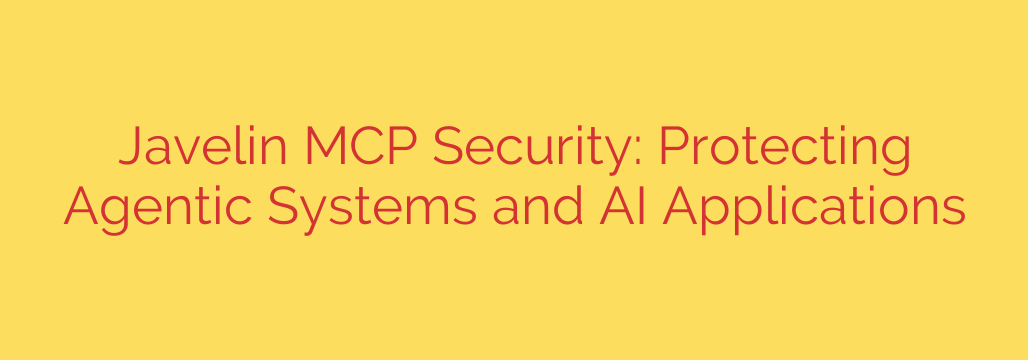
Securing AI Agents: Understanding and Mitigating Risks in Modern Applications
The era of artificial intelligence is no longer on the horizon; it’s here. Businesses are rapidly deploying AI agents and applications powered by Large Language Models (LLMs) to automate tasks, enhance customer service, and drive innovation. These “agentic systems” represent a monumental leap forward, capable of not just processing information but taking direct action—interacting with APIs, accessing databases, and executing commands.
While the potential is immense, this new capability introduces a new and critical attack surface. Traditional security measures are often blind to the unique vulnerabilities of AI agents, leaving organizations exposed to significant risks. Understanding these threats is the first step toward building a secure and resilient AI-powered future.
The New Breed of Threat: Key Vulnerabilities in Agentic AI
Unlike traditional software with predictable inputs and outputs, LLM-based agents operate on natural language, making them susceptible to manipulation in ways that conventional security tools can’t detect. It’s crucial to recognize and defend against these emerging threats.
Key security risks include:
- Malicious Prompt Injection: This is one of the most significant threats to AI agents. An attacker can craft a deceptive prompt that tricks the AI into ignoring its original instructions and executing a malicious command instead. This could involve bypassing security filters, revealing sensitive data, or triggering harmful actions through connected tools.
- Data Exfiltration: AI agents are often connected to internal knowledge bases, databases, and sensitive documents to provide accurate, context-aware responses. Attackers can manipulate an agent into leaking confidential customer information, proprietary code, or strategic business plans simply by asking the right—or wrong—questions.
- Unauthorized Tool and API Use: The real power of agentic systems lies in their ability to use tools, such as sending an email, querying a database, or interacting with a third-party API. A compromised agent could be tricked into deleting critical data, making unauthorized purchases, or executing disruptive API calls, causing serious operational and financial damage.
- Privilege Escalation: An attacker might exploit an agent to gain access to systems or data far beyond its intended permissions. By manipulating the AI, they can effectively escalate their own privileges within your network, turning a limited-access application into a gateway for a widespread breach.
Why Traditional Security Measures Fall Short
Your existing security stack, including Web Application Firewalls (WAFs), is essential for protecting against known threats like SQL injection and cross-site scripting. However, these tools are fundamentally unprepared for the nuances of AI security.
WAFs operate on defined rules and pattern matching. They can’t understand the intent or context of a natural language prompt. A prompt designed to exfiltrate data might not contain any traditionally “malicious” code, allowing it to sail past conventional defenses undetected. Protecting AI requires a security paradigm that can analyze context, monitor behavior, and understand the logic of LLM interactions.
A Modern Framework for AI Agent Security
To protect your AI applications effectively, you need a dedicated, modern security approach built for the agentic era. This framework is based on a few core principles:
- Full Observability and Monitoring: You cannot protect what you cannot see. It is essential to have complete visibility into every prompt, response, and tool used by your AI agents. This includes monitoring for anomalous behavior, tracking data access, and maintaining a detailed audit trail of all actions performed by the AI.
- Granular Policy Enforcement: Security must be proactive, not reactive. Organizations need the ability to set and enforce specific, granular policies that govern agent behavior. This means defining clear rules about which data sources an agent can access, which APIs it can call, and what types of actions it is permitted to take. If a prompt attempts to violate these policies, it should be blocked automatically.
- Context-Aware Threat Detection: An effective AI security solution must go beyond simple keyword filtering. It needs to understand the context and intent behind user prompts to accurately identify sophisticated attacks like prompt injection. By analyzing the entire interaction, the system can detect subtle manipulations that would otherwise be missed.
Actionable Steps to Secure Your AI Deployments
Protecting your organization requires a deliberate and proactive security strategy. Here are essential steps every business should take when deploying agentic AI systems:
- Map Your AI Attack Surface: Identify all points where AI agents interact with users, data, and internal or external tools. Understand the flow of information and the potential for manipulation at each step.
- Enforce the Principle of Least Privilege: Grant your AI agents the absolute minimum level of access and permissions required to perform their intended function. If an agent only needs to read from a database, do not give it write or delete permissions.
- Implement Robust Input and Output Validation: Treat all inputs as untrusted. Sanitize and validate prompts before they are processed by the LLM and scrutinize the outputs and actions generated by the agent before they are executed.
- Adopt a Dedicated AI Security Platform: Invest in a security solution specifically designed to provide runtime protection for AI applications. Look for capabilities like real-time monitoring, policy enforcement, and context-aware threat detection to create a robust defense layer around your agents.
- Continuously Audit and Test: The threat landscape is constantly evolving. Regularly audit your AI systems, test for vulnerabilities, and stay informed about the latest attack techniques to ensure your defenses remain effective.
The future of business will be driven by AI agents. By taking a proactive and informed approach to security, you can harness their transformative power with confidence, ensuring that your innovation is built on a foundation of safety and trust.
Source: https://www.helpnetsecurity.com/2025/08/20/javelin-mcp-security/








